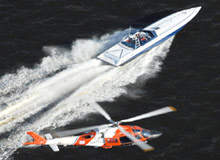
In the first weekend of 2008, five Iranian patrol boats approached three US Navy ships in the Strait of Hormuz. According to official US reports immediately following the incident, the speedboats buzzed around the US warships for half an hour at ranges as close as 200m, dropped floating objects into the water in the ships’ path, and radioed suicide-attack threats over open channels.
Although the warships – the Ticonderoga Class cruiser USS Port Royal, the Burke Class destroyer USS Hopper, and the Perry Class frigate USS Ingraham – did not open fire on the Iranian vessels, a gunner on one ship trained a portable machine gun on a speedboat that was especially close.
Reports from non-US sources subsequently indicated that the incident was not as provocative as the Pentagon originally presented it. Nevertheless, the threat posed by small fast craft to larger warships is serious, particularly in the environment where such encounters are most likely to occur.
SNEAK PREVIEW: THE ‘MILLENNIUM CHALLENGE 2002’ WARGAME
In August 2002, US military planners simulated an attack that echoed the January incident. In the simulation, the hostile red team launched scores of speedboats in rapid charges at blue team carrier and amphibious task forces in the Strait of Hormuz, which is not only narrow and congested but also features the nautical equivalent of a mountain road switchback.
The speedboats not only fired off rockets and machine guns, but also carried high-explosive payloads and rammed blue vessels in a manner similar to the attack on the USS Cole in 2000. Even though it fought back with naval artillery and missile fire, the blue team lost 16 major warships by the end of the simulated attack.
Although the war game also included missile attacks on the blue fleet from landward launchers and aircraft, the speedboat fleet alone proved to be a trickier adversary than US naval officers expected. According to Lt General Paul Van Riper, the nominal red team commander, speedboat flotillas can execute swarming tactics that appear to be the optimal method by which hordes of small units can defeat larger but fewer units – regardless of whether the units are ants attacking snakes,
wolves attacking bison, or Iranian Revolutionary Guardsmen attacking the US Navy.
In a New York Times interview, Gen. Van Riper recalled that “the sheer numbers involved overloaded the [blue team’s] ability, both mentally and electronically, to handle the attack,” adding that “the whole [attack] was over in five, maybe ten minutes.”
The simulation naturally produced two questions: the participating officers asked how the outcome happened, and the Pentagon as a whole asked if this could really happen.
SMOKE ON THE WATER: INSURGENCY GETS WET
Probably the best way to understand the speedboat threat, whether from Iran or any other nation, is to frame it as the maritime equivalent of the quasi-urban insurgency in Iraq. The whole basis of insurgent or guerrilla warfare is to attack the larger adversary only at their points of weakness, and ideally to create a situation where many individual weaknesses reinforce each other.
The current naval environment highlights two problems in particular, the first of which is cost asymmetry. First, the US Navy has shrunk to 280 ships (its smallest roster since the 1930s) while the cost of the average surface combatant has climbed to stratospheric levels.
Roughly averaging various unit costs under various accounting methods, for example, the USS Hopper cost some $500m to build and outfit. Considering that 40ft cigarette racing boats can be purchased for roughly half a million dollars, the implied cost ratio of 1,000:1 means that Iran could deploy five times as many vessels as General Van Riper did in the wargame and still have enough spare change for a boatload of cruise missiles.
By starting their tactical offense from close range (i.e. under a kilometre), speedboats turn the target engagement calculus in their favour by removing the ships’ big-ticket weapons from considerations.
Even in moderately choppy waters, modified cigarette-style hulls can still manage 30kt (40mph, or 60km/h), which means that a single boat needs only a minute to close on a warship from a kilometre away, and only 12 seconds from 200m away.
Now, cruisers and destroyers such as the Port Royal and Hopper carry eight terminal-range weapons systems: two Phalanx 20mm cannon primarily used for anti-missile defence, two Bushmaster 20mm cannon, and four portable / mountable .50-calibre machine guns.
Assuming that all these stations could lay down accurate fire – and marines handling heavy MGs on rolling decks do not always attain sniper-level marksmanship – a ten-second engagement cycle would enable a single ship to stop 48 onrushing speedboats in a minute, theoretically.
But what happens if a clever adversary takes a hint from a basketball or football coach and ‘floods a zone’ (overloads a specific quadrant) with a preponderance of boats? Herein lies the weakness of point-blank ship defences: they have the same conceptual weakness as terrestrial fixed defences such as the Maginot line.
Therefore, even the foregoing simplistic analysis demonstrates that ‘boats behaving badly’ could present a real threat.




